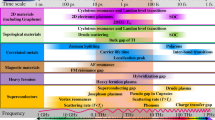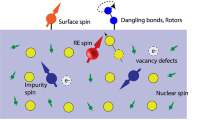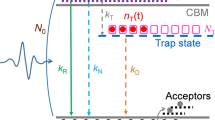Abstract
Laser cooling and electromagnetic traps have led to a revolution in atomic physics, yielding dramatic discoveries ranging from Bose–Einstein condensation to the quantum control of single atoms1. Of particular interest, because they can be used in the quantum control of one atom by another, are excited Rydberg states2,3,4, where wavefunctions are expanded from their ground-state extents of less than 0.1 nm to several nanometres and even beyond; this allows atoms far enough apart to be non-interacting in their ground states to strongly interact in their excited states. For eventual application of such states5, a solid-state implementation is very desirable. Here we demonstrate the coherent control of impurity wavefunctions in the most ubiquitous donor in a semiconductor, namely phosphorus-doped silicon. In our experiments, we use a free-electron laser to stimulate and observe photon echoes6,7, the orbital analogue of the Hahn spin echo8, and Rabi oscillations familiar from magnetic resonance spectroscopy. As well as extending atomic physicists’ explorations1,2,3,9 of quantum phenomena to the solid state, our work adds coherent terahertz radiation, as a particularly precise regulator of orbitals in solids, to the list of controls, such as pressure and chemical composition, already familiar to materials scientists10.




Similar content being viewed by others
References
Haeffner, H., Roos, C. F. & Blatt, R. Quantum computing with trapped ions. Phys. Rep. 469, 155–203 (2008)
Urban, E. et al. Observation of Rydberg blockade between two atoms. Nature Phys. 5, 110–113 (2009)
Gaëtan, A. et al. Observation of collective excitation of two individual atoms in the Rydberg blockade regime. Nature Phys. 5, 115–118 (2009)
Schwarzschild, B. Experiments show blockading interaction of Rydberg atoms over long distances. Phys. Today 62, 15–18 (2009)
Stoneham, A. M., Fisher, A. J. & Greenland, P. T. Optically driven silicon-based quantum gates with potential for high-temperature operation. J. Phys. Condens. Matter 15, L447–L451 (2003)
Abella, I. D., Kurnit, N. A. & Hartmann, S. R. Photon echoes. Phys. Rev. 141, 391–405 (1966)
Allen, L. & Eberly, J. H. Optical Resonance and Two-level Atoms 195–220 (Dover, 1987)
Hahn, E. L. Spin echoes. Phys. Rev. 80, 580–594 (1950)
Raitzsch, U. et al. Echo experiments in a strongly interacting Rydberg gas. Phys. Rev. Lett. 100, 013002 (2008)
Tokura, Y. & Nagaosa, N. Orbital physics in transition-metal oxides. Science 288, 462–468 (2000)
Zrenner, A. et al. Coherent properties of a two-level system based on a quantum dot photodiode. Nature 418, 612–614 (2002)
Kroner, M. et al. Rabi splitting and ac-Stark shift of a charged exciton. Appl. Phys. Lett. 92, 031108 (2008)
Kohn, W. & Luttinger, J. M. Theory of donor states in silicon. Phys. Rev. 98, 915–922 (1955)
Karaiskaj, D., Stotz, J. A. H., Meyer, T., Thewalt, M. L. W. & Cardona, M. Impurity absorption spectroscopy in 28Si: the importance of inhomogeneous isotope broadening. Phys. Rev. Lett. 90, 186402 (2003)
Vinh, N. Q. et al. Silicon as a model ion trap: time domain measurements of donor Rydberg states. Proc. Natl Acad. Sci. USA 105, 10649–10653 (2008)
Tsyplenkov, V. V., Demidov, E. V., Kovalevski, K. A. & Shastin, V. N. Relaxation of excited donor states in silicon with emission of intervalley phonons. Semiconductors 42, 1016–1022 (2007)
Oepts, D., van der Meer, A. F. G. & & van Amersfoort, P. W. The free electron laser facility FELIX. Infrared Phys. Technol. 36, 297–308 (1995)
Shoemaker, R. L. in Laser and Coherence Spectroscopy (ed. Steinfeld, J. I.) 197–372 (Plenum, 1978)
Agarwal, G. S. Quantum statistical theory of optical resonance phenomena in fluctuating laser fields. Phys. Rev. A 18, 1490–1506 (1978)
Larsen, D. M. Concentration broadening of absorption lines from shallow donors in multivalley bulk semiconductors. Phys Rev B 67, 165204 (2003)
Jagannath, C., Grabowski, Z. W. & Ramdas, A. K. Linewidths of the electronic excitation spectra of donors in silicon. Phys. Rev. B 23, 2082–2098 (1981)
Brown, R. A. & Rodriguez, S. Low-temperature recombination of electrons and donors in n-type germanium and silicon. Phys. Rev. 153, 890–900 (1967)
Ruess, F. J. et al. Towards atomic-scale device fabrication in silicon using scanning probe microscopy. Nano Lett. 4, 1969–1973 (2004)
Petta, J. R. et al. Coherent manipulation of electron spins in semiconductor quantum dots. Science 309, 2180–2184 (2005)
Knippels, G. M. H. et al. Generation and complete electric-field characterization of intense ultrashort tunable far-infrared laser pulses. Phys. Rev. Lett. 83, 1578–1581 (1999)
Acknowledgements
We are grateful for conversations with A. J. Fisher, A. M. Stoneham, C. Kay and G. Morley; to R. Hulet for pointing out ref. 8; and for experimental assistance from K. Litvinenko and G. Morley. We acknowledge financial support from the Netherlands Organisation for Scientific Research and the Engineering and Physical Sciences Research Council (COMPASSS, grant reference EP/H026622/1, and Advanced Research Fellowship EP/E061265/1).
Author information
Authors and Affiliations
Contributions
N.Q.V. and C.R.P. initiated this work; P.T.G., S.A.L., B.N.M., N.Q.V. and G.A. designed the research programme; N.Q.V., P.T.G., S.A.L., A.F.G.v.d.M. and B.R. performed the experiments; P.T.G. performed the theory and analysis; and P.T.G., B.N.M., S.A.L. and G.A. wrote the paper.
Corresponding author
Ethics declarations
Competing interests
The authors declare no competing financial interests.
Supplementary information
Supplementary Information
This file contains Supplementary Information and Data, and Supplementary Figures S1-S4 with legends. (PDF 378 kb)
Rights and permissions
About this article
Cite this article
Greenland, P., Lynch, S., van der Meer, A. et al. Coherent control of Rydberg states in silicon. Nature 465, 1057–1061 (2010). https://doi.org/10.1038/nature09112
Received:
Accepted:
Issue Date:
DOI: https://doi.org/10.1038/nature09112
- Springer Nature Limited
This article is cited by
-
Enhanced coherent transition radiation from midinfrared-laser-driven microplasmas
Scientific Reports (2022)
-
Highly efficient THz four-wave mixing in doped silicon
Light: Science & Applications (2021)
-
Observation of a marginal Fermi glass
Nature Physics (2021)
-
Giant non-linear susceptibility of hydrogenic donors in silicon and germanium
Light: Science & Applications (2019)
-
Giant multiphoton absorption for THz resonances in silicon hydrogenic donors
Nature Photonics (2018)





